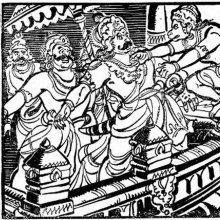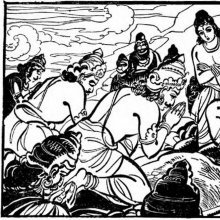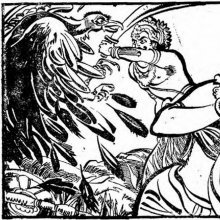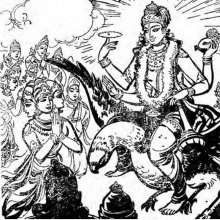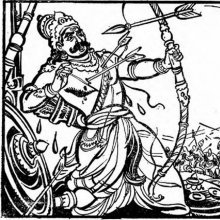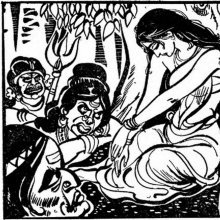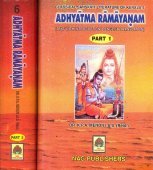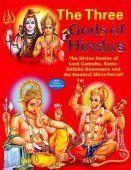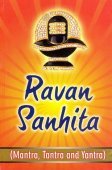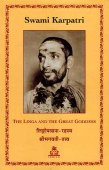Ravana, Rāvaṇa, Ravaṇa, Ravāṇā, Ravāṉā: 37 definitions
Introduction:
Ravana means something in Buddhism, Pali, Hinduism, Sanskrit, Jainism, Prakrit, the history of ancient India, Marathi, Hindi, Tamil. If you want to know the exact meaning, history, etymology or English translation of this term then check out the descriptions on this page. Add your comment or reference to a book if you want to contribute to this summary article.
Images (photo gallery)
(+22 more images available)
In Hinduism
Natyashastra (theatrics and dramaturgy)
Source: archive.org: The mirror of gesture (abhinaya-darpana)One of the Hands of Famous Emperors.—Rāvaṇa: the same hands with widely separated fingers, feathered.

Natyashastra (नाट्यशास्त्र, nāṭyaśāstra) refers to both the ancient Indian tradition (shastra) of performing arts, (natya—theatrics, drama, dance, music), as well as the name of a Sanskrit work dealing with these subjects. It also teaches the rules for composing Dramatic plays (nataka), construction and performance of Theater, and Poetic works (kavya).
Purana and Itihasa (epic history)
Source: archive.org: Puranic EncyclopediaRāvaṇa (रावण).—The Rākṣasa King of Laṅkā who had ten heads. Genealogy. Descended from Viṣṇu thus:—Brahmā—Pulastya—Viśravas—Rāvaṇa. (See full article at Story of Rāvaṇa from the Puranic encyclopaedia by Vettam Mani)
Source: Triveni: Masumatti (A Story)He (an old man) told me of a mantap where Ravana had been held prisoner, and made to dance for the amusement of the Mahishmati people, as a great glittering ten-headed monster. The captive had at first refused to perform, but Arjuna had struck him so, that he started up in rage and pain striking ten dents, with his ten heads, into the stone ceiling of the prison. The dents–the old man said–could be seen to this day.
Source: Cologne Digital Sanskrit Dictionaries: The Purana Index1) Ravana (रवन).—Son of Dharma (Vasu).*
- * Viṣṇu-purāṇa I. 15. 113.
2) Rāvaṇa (रावण).—A son of Viśravas and Keśinī;1 pleased Śiva by his praises;2 afraid of Māndhāta;3 heard of Śītā's beauty and set up Mārīca to display himself as a golden deer and entice Rāma away;4 resented Arjuna-Haihaya's action in ruining his camp by blocking a river and was overpowered by him in the presence of women and imprisoned in his capital Māhiṣmatī;5 pursued by the king of kites, compared to Indra being pursued by Vīra;6 killed by Rāma;7 lost his kingdom through pride of power; desire for more territory.8 Vanquished by Vāli at Puṣkara, agreed to be his ally.9 A description of:10 Killed Anaraṇya;11 also Daśagrīva; defeated by Kārtavīrya and released at the request of Pulastya.12
- 1) Bhāgavata-purāṇa VII. 1. 43; IV. 1. 37; Brahmāṇḍa-purāṇa III. 8. 47; Vāyu-purāṇa 70. 41-8.
- 2) Bhāgavata-purāṇa X. 88. 16.
- 3) Ib. IX. 6. 33.
- 4) Ib. IX. 10. 10
- 5) Ib. IX. 15. 21-2; Brahmāṇḍa-purāṇa III. 32. 50; 69. 35-7.
- 6) Bhāgavata-purāṇa IV. 19. 16-17.
- 7) Ib. VII. 1. 44; 10. 36; X. 40. 20; Brahmāṇḍa-purāṇa III. 8. 54; Matsya-purāṇa 12. 50; 47. 245; Vāyu-purāṇa 88. 197; 94. 35; 98. 92.
- 8) Bhāgavata-purāṇa X. 73. 20; XII. 3. 11.
- 9) Brahmāṇḍa-purāṇa III. 7. 248-67.
- 10) Ib. III. 8. 48-50.
- 11) Ib. III. 63. 74; Vāyu-purāṇa 88. 75; Viṣṇu-purāṇa IV. 3. 17; 15. 1.
- 12) Matsya-purāṇa 43. 37-9.
Rāvaṇa (रावण) is a name mentioned in the Mahābhārata (cf. VIII.4.52) and represents one of the many proper names used for people and places. Note: The Mahābhārata (mentioning Rāvaṇa) is a Sanskrit epic poem consisting of 100,000 ślokas (metrical verses) and is over 2000 years old.
Source: Shodhganga: The saurapurana - a critical studyRāvaṇa (रावण) is one of the sons of Kaikasī and Viśravas, according to one account of Vaṃśa (‘genealogical description’) of the 10th century Saurapurāṇa: one of the various Upapurāṇas depicting Śaivism.—Accordingly, [...] Viśravas was born to [Ilavilā and Pulastya]. Viśravas had four wives—Puṣpotkaṭā, Vākā, Kaikasī and Devavarṇinī. From Kaikasī were born Rāvaṇa, Kumbhakarṇa, Vibhīṣaṇa and Śūrpaṇakhā.
Rāvaṇa is the demon who abducted Sītā (wife of Rāma) from the forest, according to the Vaṃśānucarita section of the Saurapurāṇa.—Accordingly, [...] Demon Rāvaṇa abducted Sītā from the forest and took her to Laṃka. [...] Having constructed a bridge across the ocean Rāma went to Laṃka with His army and fought with Rāvaṇa who was killed along with the demon force.

The Purana (पुराण, purāṇas) refers to Sanskrit literature preserving ancient India’s vast cultural history, including historical legends, religious ceremonies, various arts and sciences. The eighteen mahapuranas total over 400,000 shlokas (metrical couplets) and date to at least several centuries BCE.
Vaishnavism (Vaishava dharma)
Source: ISKCON Press: GlossaryRāvaṇa (रावण).—A powerful ten-headed demon king of Laṅkā who wanted to build a staircase to heaven but was killed by Kṛṣṇa in His incarnation as Lord Rāmacandra. The pastime is described in the epic poem Rāmāyaṇa, by the sage Vālmīki.

Vaishnava (वैष्णव, vaiṣṇava) or vaishnavism (vaiṣṇavism) represents a tradition of Hinduism worshipping Vishnu as the supreme Lord. Similar to the Shaktism and Shaivism traditions, Vaishnavism also developed as an individual movement, famous for its exposition of the dashavatara (‘ten avatars of Vishnu’).
Shilpashastra (iconography)
Source: Archaeological Survey of India: Śaiva monuments at Paṭṭadakal (śilpa)Rāvaṇa (रावण), son of Ṛṣi Pulastya, was born with the energy of ten persons, according to some sources. But in later literature he has been given ten heads and twenty hands. Rāvaṇa, an important character in Rāmāyaṇa is thus pictured as a demon, the puissant king of Laṅkā.
Also it is said that in the beginning, Rāvaṇa had eleven heads and twenty-two hands. He used one of his heads and two of his hands to make a vīṇā. He played on it and sang to propitiate the Lord. Pleased with his devotion and music, Śiva showered blessings. Sometimes this story is interpreted in pictures.

Shilpashastra (शिल्पशास्त्र, śilpaśāstra) represents the ancient Indian science (shastra) of creative arts (shilpa) such as sculpture, iconography and painting. Closely related to Vastushastra (architecture), they often share the same literature.
Kavya (poetry)
Source: Wisdom Library: KathāsaritsāgaraRāvaṇa (रावण) was slain by Rāma after he kidnapped his wife Sītā, the king of Ayodhyā, according to in the Kathāsaritsāgara, chapter 51. Accordingly, “... as fate would have it, his father [Daśaratha] handed over the kingdom to Bharata, and sent Rāma to the forest with Sītā and Lakṣmaṇa. There Rāvaṇa carried off his beloved Sītā by magic, and took her to the city of Laṅkā, having slain Jaṭāyus on the way”.
The story of Rāvaṇa was narrated by the Vidyādharī Kāñcanaprabhā to Naravāhanadatta while in a Svayambhū temple of Śiva, in order to demonstrate that “people who possess firmness endure for a long time mutual separation to which no termination is assigned”, in other words, that “heroic souls endure separation for so long a time”.
The Kathāsaritsāgara (‘ocean of streams of story’), mentioning Rāvaṇa, is a famous Sanskrit epic story revolving around prince Naravāhanadatta and his quest to become the emperor of the vidyādharas (celestial beings). The work is said to have been an adaptation of Guṇāḍhya’s Bṛhatkathā consisting of 100,000 verses, which in turn is part of a larger work containing 700,000 verses.

Kavya (काव्य, kavya) refers to Sanskrit poetry, a popular ancient Indian tradition of literature. There have been many Sanskrit poets over the ages, hailing from ancient India and beyond. This topic includes mahakavya, or ‘epic poetry’ and natya, or ‘dramatic poetry’.
General definition (in Hinduism)
Source: Wisdom Library: HinduismRāvaṇa (रावण, screamer, roarer”):—In Vedic hinduism, he is one of the half-brothers of Kubera. Rāvaṇa drove Kubera away from his capital in Laṅka and took over. Kubera was the Vedic God of wealth presiding over all earthly treasures.
Source: Apam Napat: Indian MythologyRavana was a demon king, who had unleashed a reign of terror from his kingdom at Lanka. He abducted Sita, the wife of Rama. Rama invaded Lanka with an army of monkeys and killed Ravana and rescued his wife.
Source: WikiPedia: Hinduism1) Rāvaṇa is the primary antagonist character of the Hindu epic Ramayana; who was the Rakshasa king of Lanka. In the classic text, he is mainly depicted negatively, kidnapping Rama's wife Sita, to claim vengeance on Rama and his brother Lakshmana for having cut off the nose of his sister Surpanakha. Ravana is described as a devout follower of the god Shiva in addition to his tribe's religious beliefs, a great scholar, a capable ruler and a maestro of the Veena.
2) Rāvaṇa (रावण): King of Lanka who abducted Sita, the beautiful wife of Ramachandra. Ravana is depicted in art with up to ten heads, signifying that he had knowledge spanning all the ten directions.
Etymology: The name 'Ravana' obtains from the root 'ru' 'raavayati iti raavanah' 'one who makes god love by his compassion actions.' The name Ravana obtains from the root, 'Ra' signifies the sun and 'vana' signifies generation according to a nationalist Sinhala scholar, Arisen. Ravana had many other popular names such as Dasis Ravana, Ravan, Raavan, Ravula, Lankeshwar, Ravanaeshwaran all signifying the qualities of his life. Ravana was a cross of Brahmin and Daitya thus attaining a status of BrahmaRakshasa.
Source: Experience Festival: HinduismRavana: Ten-headed demoniac ruler during the time of Lord Rama. (BV-33). Rakshasa Emperor at Lanka (RRV2-2)
In Buddhism
Tibetan Buddhism (Vajrayana or tantric Buddhism)
Source: Wisdom Library: Tibetan BuddhismRāvaṇa (रावण) is the name of a Rākṣasa mentioned as attending the teachings in the 6th century Mañjuśrīmūlakalpa: one of the largest Kriyā Tantras devoted to Mañjuśrī (the Bodhisattva of wisdom) representing an encyclopedia of knowledge primarily concerned with ritualistic elements in Buddhism. The teachings in this text originate from Mañjuśrī and were taught to and by Buddha Śākyamuni in the presence of a large audience (including Rāvaṇa).

Tibetan Buddhism includes schools such as Nyingma, Kadampa, Kagyu and Gelug. Their primary canon of literature is divided in two broad categories: The Kangyur, which consists of Buddha’s words, and the Tengyur, which includes commentaries from various sources. Esotericism and tantra techniques (vajrayāna) are collected indepently.
In Jainism
General definition (in Jainism)
Source: Wisdom Library: JainismRāvaṇa (रावण) is the name of the eighth Prativāsudeva according to both Śvetāmbara and Digambara sources. He is also known by the name Laṅkeśa or Daśamukha (‘ten-faced’). Jain legends describe nine such Prativāsudevas (anti-heroes) usually appearing as powerful but evil antagonists instigating Vāsudeva by subjugating large portions of Bharata-land. As such, they are closely related with the twin brothers known as the Vāsudevas (“violent heroes”) and the Baladevas (“gentle heroes”).
According to the Triṣaṣṭiśalākāpuruṣacarita 7.1, the mother of Rāvaṇa (or Daśamukha, Laṅkeśa) is named Ratnaśravas and his mother Kaikasī. Accordingly, “Ratnaśravas gave him the name Daśamukha because his face was united with the nine rubies”. Rāvaṇa has two elder brothers named Bhānukarṇa (or Kumbhakarṇa) and Bibhīṣaṇa, and a sister named Candraṇakhā (or Śūrpaṇakhā).
The Prativāsudevas (such as Rāvaṇa) fight against the twin-heroes with their cakra-weapon but at the final moment are killed by the Vāsudevas. Their stories are narrated in the Triṣaṣṭiśalākāpuruṣacarita (“the lives of the sixty-three illustrious persons”), a twelfth-century Śvetāmbara work by Hemacandra.
Source: archive.org: TrisastisalakapurusacaritraRāvaṇa (रावण) (also called Daśamukha) is a son of Rākṣasa Ratnaśravas (son of Sumālin) and Vidyādharī Kaikasī (daughter of Vyomabindu), according to the Jain Ramayana and chapter 7.1 [origin of the rākṣasavaṃśa and vānaravaṃśa] of Hemacandra’s 11th century Triṣaṣṭiśalākāpuruṣacaritra: an ancient Sanskrit epic poem narrating the history and legends of sixty-three illustrious persons in Jainism.
Accordingly, “[...] [Kaikasī] bore a son, who made the seats of his enemies shake, with a life-term of more than twelve thousand years. Leaping about on the birth-couch, very strong, shaking the earth, resting on his back, with a proud red lotus of a foot, with, his hand he drew a necklace made of nine rubies from a casket standing near, a necklace which was a present in the past from Indra Bhīma. From inherent arrogance the child put the necklace around his neck and Kaikasī and her attendants were amazed. [...] At once Ratnaśravas gave him ‘the name ‘Daśamukha’ because his face was united with the nine rubies. [...]”.
Source: academia.edu: Tessitori Collection IRāvaṇa (रावण) or Rāvaṇadṛṣṭānta refers to one of the 157 stories embedded in the Kathāmahodadhi by Somacandra (narrating stories from Jain literature, based on the Karpūraprakara), which is included in the collection of manuscripts at the ‘Vincenzo Joppi’ library, collected by Luigi Pio Tessitori during his visit to Rajasthan between 1914 and 1919.—The Kathāmahodadhi represents a repository of 157 stories [e.g., Rāvaṇa-dṛṣṭānta] written in prose Sanskrit, although each of them is preceded by a verse. Together, they stage a large number of Jain characters (including early teachers). [...]

Jainism is an Indian religion of Dharma whose doctrine revolves around harmlessness (ahimsa) towards every living being. The two major branches (Digambara and Svetambara) of Jainism stimulate self-control (or, shramana, ‘self-reliance’) and spiritual development through a path of peace for the soul to progess to the ultimate goal.
India history and geography
Source: academia.edu: The Chronological History of Ancient Sri LankaKing Ravana of Ramayana era (5677-5577 BCE).—Rajavaliya, a Simhalese chronicle mentions that Simhala king Ravana reined over Sri Lanka around 3609 BCE 1844 years before the 1765 BCE. Historians calculated this date around 2300 BCE considering the date of Buddha nirvana around 483 BCE. Numerous sources and traditions of Sri Lanka also establish that Ravana and Vibhishana were the kings of Sri Lanka. Buddhist text Lankavatara Sutra mentions that Ravana was a great follower of Buddhism. Evidently, Buddhists concocted it to convince the Simhalese people that their great king Ravana also followed Buddhism.
Ravana belonged to Pulastya gotra. The ancestors of Ravana had politically dominated in South India and Sri Lanka during pre-Ramayana era. Valmiki Ramayana informs us that Ravana and Vaishravana were the sons of Vishravas and Kaikesi. Seemingly, Vaishravana became the king of Sri Lanka and Ravana inherited the kingdom of his father in South India. The golden city of Lankapuri was designed and built by Vishvakarma. Lankapuri was the most beautiful city of the world during Ramayana era. Ravana forcibly took over the city of Lankapuri and Pushpaka Vimana from his brother Vaishravana also known as Kubera. Thus, Ravana became the emperor of a vast kingdom extended from Sri Lanka to Dandakaranya of South India.

The history of India traces the identification of countries, villages, towns and other regions of India, as well as mythology, zoology, royal dynasties, rulers, tribes, local festivities and traditions and regional languages. Ancient India enjoyed religious freedom and encourages the path of Dharma, a concept common to Buddhism, Hinduism, and Jainism.
Languages of India and abroad
Pali-English dictionary
Source: BuddhaSasana: Concise Pali-English Dictionaryravana : (nt.) roaring; howling.
Source: Sutta: The Pali Text Society's Pali-English DictionaryRavaṇa, (adj. -nt.) (fr. ravati) roaring, howling, singing, only in cpd. °ghaṭa a certain kind of pitcher, where meaning of ravaṇa is uncertain. Only at identical passages (in illustration) Vism. 264=362=KhA 68 (reading peḷā-ghaṭa, but see App. p. 870 ravaṇa°)= VbhA. 68 (where v. l. yavana°, with?). (Page 566)

Pali is the language of the Tipiṭaka, which is the sacred canon of Theravāda Buddhism and contains much of the Buddha’s speech. Closeley related to Sanskrit, both languages are used interchangeably between religions.
Marathi-English dictionary
Source: DDSA: The Molesworth Marathi and English Dictionaryravānā (रवाना).—p a ind ( P) Set out; started in order to go; departed. v kara & hō.
--- OR ---
ravānā (रवाना).—m ( P) A pass or a permit.
--- OR ---
rāvaṇa (रावण).—m (S) The sovereign of Lanka or Ceylon, killed by Rama or Ramachandra. Hence, appellatively, a huge and ugly fellow. Pr. rāvaṇāsa bhikēcē ḍōhaḷē Used (in allusion to the legend of Rawan̤'s assuming the garb and air of a beggar to carry off Sita) in predicting, from his adopting low and mean artifices, the ruin or fall of a person. rāvaṇa or rāvaṇācī laṅkā jaḷaṇēṃ The singing or din of the ears when closed up. rāvaṇa mājaṇēṃ-mātaṇēṃ-hōṇēṃ To become very haughty or insolently refractory.
Source: DDSA: The Aryabhusan school dictionary, Marathi-Englishravānā (रवाना).—p a ind Set out; departed. n A pass or a permit.
--- OR ---
rāvaṇa (रावण).—m The sovereign of laṅkā. A huge and ugly fellow. rāvaṇa mājaṇēṃ To become very insolent.
Marathi is an Indo-European language having over 70 million native speakers people in (predominantly) Maharashtra India. Marathi, like many other Indo-Aryan languages, evolved from early forms of Prakrit, which itself is a subset of Sanskrit, one of the most ancient languages of the world.
Sanskrit dictionary
Source: DDSA: The practical Sanskrit-English dictionaryRavaṇa (रवण).—a. [ru-yuc Uṇādi-sūtra 2.71] Crying, roaring, screaming.
2) Sonorous, sounding; उत्कण्ठावर्धनैः शुभ्रं रवणैरम्बरं ततम् (utkaṇṭhāvardhanaiḥ śubhraṃ ravaṇairambaraṃ tatam) Bhaṭṭikāvya 7.14.
3) Sharp, hot.
4) Fickle, unsteady.
5) Jesting.
-ṇaḥ 1 A camel; स्वनाम निन्ये रवणः स्फुटार्थताम् (svanāma ninye ravaṇaḥ sphuṭārthatām) Śiśupālavadha 12.2.
2) The cuckoo.
3) A bee.
4) Sound.
5) A big cucumber.
-ṇam Brass, bell-metal.
--- OR ---
Rāvaṇa (रावण).—a. [ru-ṇic lyu] Crying, screaming, roaring, bewailing; इत्युक्त्वा परुषं वाक्यं रावणः शत्रुरावणः (ityuktvā paruṣaṃ vākyaṃ rāvaṇaḥ śatrurāvaṇaḥ) Rām.3.56. 26 (com. śatrūn rāvayati krośayati śatrarāvaṇaḥ).
-ṇaḥ Name of a celebrated demon, king of Laṅkā and the chief of the Rākṣasas; स रावणो नाम निकामभीषणं बभूव रक्षः क्षतरक्षणं दिवः (sa rāvaṇo nāma nikāmabhīṣaṇaṃ babhūva rakṣaḥ kṣatarakṣaṇaṃ divaḥ) Śiśupālavadha 1.48. [He was the son of Viśravas by Keśinī or Kaikaśī and so half-brother of Kuber. He is called Paulastya as being a grandson of the sage Pulastya. Laṅkā was originally occupied by Kubera, but Rāvaṇa ousted him from it and made it his own capital. He had ten heads (and hence his names Daśagrīva, Daśavadana &c.) and twenty arms, and according to some, four legs (cf. R.12.88 and Malli.). He is represented to have practised the most austere penance for ten thousand years in order to propitiate the god Brahman, and to have offered one head at the end of each one thousand years. Thus he offered nine of his heads and was going to offer the tenth when the God was pleased and granted him immunity from death by either god or man. On the strength of this boon he grew very tyrannical and oppressed all beings. His power became so great that even the gods are said to have acted as his domestic servants. He conquered almost all the kings of the day, but is said to have been imprisoned by Kārtavīrya for some time when he went to attack his territory. On one occasion he tried to uplift the Kailāsa mountain, but Śiva pressed it down so as to crush his fingers under it. He, therefore, hymned Śiva for one thousand years so loudly that the God gave him the name Rāvaṇa and freed him from his painful position. But though he was so powerful and invincible, the day of retribution drew near. While Rāma who was Viṣṇu descended on earth for the destruction of this very demon was passing his years of exile in the forest, Rāvaṇa carried off his wife Sītā and urged her to become his wife but she persistently refused and remained loyal to her husband. At last Rāma assisted by his monkey-troops invaded Laṅkā, annihilated Rāvaṇa's troops and killed the demon himself. He was a worthy opponent of Rāma, and hence the expression:-रामरावणयोर्युद्धं रामरावणयोरिव (rāmarāvaṇayoryuddhaṃ rāmarāvaṇayoriva) |].
-ṇam 1 The act of screaming.
2) Name of a Muhūrta.
Source: Cologne Digital Sanskrit Dictionaries: Edgerton Buddhist Hybrid Sanskrit DictionaryRavaṇa (रवण).—(?) , nt. or adj. ([Jaina Māhārāṣṭrī] id., subst. nt.; Sanskrit Gr., Lex., and artificial lit., as adj. or n. ag., crying), (1) cry, perhaps to be read in Mahāvastu i.154.9 (verse), Senart saśoka-ravitāni (…bāṣpāṇi), mss. corruptly (one syllable short) saśoka- balāni or -vanāni, read -ravaṇāni?; (2) crying, resonant, in Lalitavistara 162.9 (verse) Lefm. (with ms. A only) tūryair ghoṣā jinaruta-ravanā (so, n); but read probably -ravitā(ḥ) with v.l.; Calcutta (see LV.) and v.l. -racitā(ḥ); see ravita; (3) f. °ravaṇī, at end of a ([bahuvrīhi]?) [compound], either adj., speaking, proclaiming; or (having…) speech: Lalitavistara 286.20—21, see s.v. rutā.
--- OR ---
Rāvaṇa (रावण).—(1) name of a nāga king: Mahāvyutpatti 3245; Mahā-Māyūrī 246.32; (2) name of a yakṣa: Mahā-Māyūrī 99.
Source: Cologne Digital Sanskrit Dictionaries: Shabda-Sagara Sanskrit-English DictionaryRavaṇa (रवण).—mfn.
(-ṇaḥ-ṇā-ṇaṃ) 1. Sounding, sonorous. 2. Hot, warm, sharp. 3. Unsteady, fickle or shaking. 4. Jesting, a jester. m.
(-ṇaḥ) 1. A camel. 2. The Kokila. n.
(-ṇaṃ) 1. Bell-metal or brass. 2. Sounding. E. ru to sound, Unadi aff. yuc .
--- OR ---
Rāvaṇa (रावण).—m.
(-ṇaḥ) The Daitya-sovereign of Lanka or Ceylon, killed by Ramachandra. n.
(-ṇaṃ) Noise, tumult. E. ru to cry, (in the causal form,) aff. lyuṭa; afflicting mankind.
Source: Cologne Digital Sanskrit Dictionaries: Benfey Sanskrit-English DictionaryRavaṇa (रवण).—partly ru + ana, I. adj. 1. Sounding, crying. 2. Sharp, hot. 3. Unsteady. 4. Jesting. Ii. m. 1. The Indian cuckoo. 2. A camel. Iii. n. Bell-metal.
--- OR ---
Rāvaṇa (रावण).—m. The king of the Rākṣasas, the ravisher of Sīta, and destroyed by Rāma, [Rāmāyaṇa] 3, 48, 2.
Source: Cologne Digital Sanskrit Dictionaries: Cappeller Sanskrit-English DictionaryRavaṇa (रवण).—[adjective] roaring, howling, singing.
--- OR ---
Rāvaṇa (रावण).—[masculine] [Name] of a Rākṣasa (lit. causing to cry or lament).
Source: Cologne Digital Sanskrit Dictionaries: Aufrecht Catalogus Catalogorum1) Rāvaṇa (रावण) as mentioned in Aufrecht’s Catalogus Catalogorum:—Arkaprakāśa med.
2) Rāvaṇa (रावण):—Ṛgvedabhāṣya. Śrīsūktabhāṣya.
Source: Cologne Digital Sanskrit Dictionaries: Monier-Williams Sanskrit-English Dictionary1) Ravaṇa (रवण):—[from rava] mfn. roaring, yelling, crying, howling, singing etc., [Bhaṭṭi-kāvya]
2) [v.s. ...] sonorous (= śabdana), [cf. Lexicographers, esp. such as amarasiṃha, halāyudha, hemacandra, etc.]
3) [v.s. ...] sharp, hot (= tīkṣṇa), [cf. Lexicographers, esp. such as amarasiṃha, halāyudha, hemacandra, etc.]
4) [v.s. ...] unsteady, fickle (= cañcala), [cf. Lexicographers, esp. such as amarasiṃha, halāyudha, hemacandra, etc.]
5) [v.s. ...] m. a sound, [cf. Lexicographers, esp. such as amarasiṃha, halāyudha, hemacandra, etc.]
6) [v.s. ...] a camel, [cf. Lexicographers, esp. such as amarasiṃha, halāyudha, hemacandra, etc.]
7) [v.s. ...] the Koīl or Indian cuckoo, [cf. Lexicographers, esp. such as amarasiṃha, halāyudha, hemacandra, etc.]
8) [v.s. ...] wagtail (= bhaṇḍaka), [cf. Lexicographers, esp. such as amarasiṃha, halāyudha, hemacandra, etc.]
9) [v.s. ...] a bee, [cf. Lexicographers, esp. such as amarasiṃha, halāyudha, hemacandra, etc.]
10) [v.s. ...] a big cucumber, [cf. Lexicographers, esp. such as amarasiṃha, halāyudha, hemacandra, etc.]
11) [v.s. ...] Name of a man [gana] śivādi
12) [v.s. ...] of a serpent-king, [cf. Lexicographers, esp. such as amarasiṃha, halāyudha, hemacandra, etc.]
13) [v.s. ...] n. brass, bell-metal, [cf. Lexicographers, esp. such as amarasiṃha, halāyudha, hemacandra, etc.]
14) Ravāṇa (रवाण):—[from rava] See under √1. ru.
15) Rāvaṇa (रावण):—[from rāva] mfn. ([from] [Causal]) causing to cry (with [genitive case] or ifc.; only in this sense to explain the name of the famous Rākṣasa), [Mahābhārata; Rāmāyaṇa] etc.
16) [v.s. ...] m. Name of the ruler of Laṅkā or Ceylon and the famous chief of the Rākṣasas or demons whose destruction by Rāmacandra forms the subject of the Rāmāyaṇa (as son of Viśravas he was younger brother of Kubera, but by a different mother, Ilavila being the mother of Kubera, and Keśinī of the three other brothers Rāvaṇa Vibhīṣaṇa, and Kumbha-karṇa; he is one of the worst of the many impersonations of evil common in Hindū mythology; he has ten heads and twenty arms, symbolizing strength; this power was, as usual, acquired by self-inflicted austerities, which had obtained from Brahmā a boon, in virtue of which R° was invulnerable by gods and divine beings of all kinds, though not by men or a god in human form; as Viṣṇu became incarnate in Rāma-candra to destroy R°, so the other gods produced innumerable monkeys, bears, and various semi-divine animals to do battle with the legions of demons, his subjects, under Khara, Dūṣaṇa, and his other generals), [Mahābhārata; Rāmāyaṇa; Harivaṃśa] etc. ([Indian Wisdom, by Sir M. Monier-Williams 353])
17) [v.s. ...] [patronymic] [from] ravaṇa [gana] śivādi
18) [v.s. ...] Name of a prince of Kaśmīra, [Rājataraṅgiṇī]
19) [v.s. ...] of various authors, [Catalogue(s)]
20) [from rāva] n. the act of screaming etc., [Monier-Williams’ Sanskrit-English Dictionary]
21) [v.s. ...] Name of a Muhūrta, [Catalogue(s)]
Source: Cologne Digital Sanskrit Dictionaries: Yates Sanskrit-English Dictionary1) Ravaṇa (रवण):—[(ṇaḥ-ṇā-ṇaṃ) a.] Sonorous; hot; fickle; jesting. m. A camel; a cuckoo. n. Bell metal; sound.
2) Rāvaṇa (रावण):—(ṇaḥ) 1. m. The sovereign of Laṃkā or Ceylon killed by Rāṃchandra; noise, tumult.
Source: DDSA: Paia-sadda-mahannavo; a comprehensive Prakrit Hindi dictionary (S)Ravaṇa (रवण) in the Sanskrit language is related to the Prakrit word: Ravaṇa.
[Sanskrit to German]
Sanskrit, also spelled संस्कृतम् (saṃskṛtam), is an ancient language of India commonly seen as the grandmother of the Indo-European language family (even English!). Closely allied with Prakrit and Pali, Sanskrit is more exhaustive in both grammar and terms and has the most extensive collection of literature in the world, greatly surpassing its sister-languages Greek and Latin.
Hindi dictionary
Source: DDSA: A practical Hindi-English dictionary1) Ravānā (रवाना):—(a) departed, set out; despatched; -[karanā] to despatch; to cause to depart; —[honā] to depart, to set out.
2) Rāvaṇa (रावण) [Also spelled ravan]:—(nm) the king of ancient Ceylon who kidnapped Ram's queen consort Sita: and later fought him and was killed, villain of the great epic Ramayan; a demonic person.
...
Prakrit-English dictionary
Source: DDSA: Paia-sadda-mahannavo; a comprehensive Prakrit Hindi dictionaryRavaṇa (रवण) in the Prakrit language is related to the Sanskrit word: Ravaṇa.
Prakrit is an ancient language closely associated with both Pali and Sanskrit. Jain literature is often composed in this language or sub-dialects, such as the Agamas and their commentaries which are written in Ardhamagadhi and Maharashtri Prakrit. The earliest extant texts can be dated to as early as the 4th century BCE although core portions might be older.
Kannada-English dictionary
Source: Alar: Kannada-English corpusRavaṇa (ರವಣ):—[noun] = ರಪಣ [rapana].
--- OR ---
Ravaṇa (ರವಣ):—
1) [adjective] crying; wailing.
2) [adjective] exciting laughter; laughable; amusing.
3) [adjective] unstable; fickle; unsteady.
4) [adjective] full of or characterised by any very strong feeling or by intense activity, speed, excitement, etc., impetuous; fiery; excitable; hot.
--- OR ---
Ravaṇa (ರವಣ):—
1) [noun] an Indian cuckoo; koel.
2) [noun] a camel.
--- OR ---
Rāvaṇa (ರಾವಣ):—
1) [noun] a long, rumbling or boisterous sound.
2) [noun] a man making such a sound.
3) [noun] Rāvaṇa, the villain in the great epic Rāmāyaṇa; who abducted Sīte and was killed by Rāma.
4) [noun] a kind of vīṇe, a stringed musical instrument.
5) [noun] ರಾವಣನ ಮೀಸೆ ಹುಲ್ಲು [ravanana mise hullu] rāvaṇana mīse hullu = ರಾವಣಗೆಡ್ಡೆ - [ravanagedde -] 1.
Kannada is a Dravidian language (as opposed to the Indo-European language family) mainly spoken in the southwestern region of India.
See also (Relevant definitions)
Starts with (+24): Ravana-bhuja, Ravana-hasta, Ravanabhait, Ravanabhet, Ravanaca Lenka, Ravanaca Vajantri, Ravanaca-lenka, Ravanacaritra, Ravanacetaka, Ravanachi-mishi, Ravanaci Khai, Ravanadiva, Ravanadivali, Ravanadivi, Ravanadrishtanta, Ravanaganga, Ravanagedde, Ravanagi, Ravanagiciththi, Ravanahasra.
Ends with (+192): Abharavana, Abhidravana, Abhishravana, Abhyashravana, Abhyuddravana, Agravana, Airavana, Akshishravana, Amravana, Amritasravana, Aniladravana, Antaravana, Anudravana, Anupravana, Anuravana, Anushravana, Apadravana, Apahravana, Aparyaptadravana, Apravana.
Full-text (+1094): Vibhishana, Shurpanakha, Indrajit, Ravani, Mandodari, Kumbhakarna, Dashakantha, Dashagriva, Dashamukha, Rakshasendra, Lanka, Krurakriti, Vaishravana, Dashanana, Panktigriva, Avindhya, Shakrajit, Jatayu, Sita, Dashashiras.
Relevant text
Search found 117 books and stories containing Ravana, Rāvaṇa, Ravaṇa, Ravāṇā, Ravāṉā, Ravānā, Ravāṇa, Ravaanaa; (plurals include: Ravanas, Rāvaṇas, Ravaṇas, Ravāṇās, Ravāṉās, Ravānās, Ravāṇas, Ravaanaas). You can also click to the full overview containing English textual excerpts. Below are direct links for the most relevant articles:
Hanuman Nataka (critical study) (by Nurima Yeasmin)
Hanuman-Nāṭaka, Act 9 (Summary) < [Chapter 3]
Hanuman-Nāṭaka, Act 10 (Summary) < [Chapter 3]
Hanuman-Nāṭaka, Act 7 (Summary) < [Chapter 3]
Trishashti Shalaka Purusha Caritra (by Helen M. Johnson)
Part 7: Defeat and death of Rāvaṇa < [Chapter VII - The killing of Rāvaṇa]
Part 7: Supārśva’s omniscience < [Chapter V - Supārśvanāthacaritra]
Part 8: Śītala’s omniscience < [Chapter VIII - Śītalanāthacaritra]
Garga Samhita (English) (by Danavir Goswami)
Verse 6.20.10 < [Chapter 20 - In the Description of the Second Fort, the Glories of Indra-tīrtha, etc.]
Verse 5.11.3 < [Chapter 11 - The Stories of Kubjā and Kuvalayāpīḍa]
Verse 4.9.9 < [Chapter 9 - The Glories of Srī Ekādaśī]
Puranic encyclopaedia (by Vettam Mani)
Sahitya-kaumudi by Baladeva Vidyabhushana (by Gaurapada Dāsa)
Text 7.103 < [Chapter 7 - Literary Faults]
Text 10.155 < [Chapter 10 - Ornaments of Meaning]
Text 4.95 < [Chapter 4 - First-rate Poetry]
Brihad Bhagavatamrita (commentary) (by Śrī Śrīmad Bhaktivedānta Nārāyana Gosvāmī Mahārāja)
Verse 1.5.16-17 < [Chapter 5 - Priya (the beloved devotees)]
Verse 1.4.33 < [Chapter 4 - Bhakta (the devotee)]
Verse 1.2.67-71 < [Chapter 2 - Divya (the celestial plane)]
Related products
(+4 more products available)
